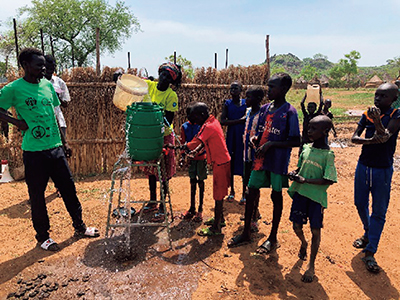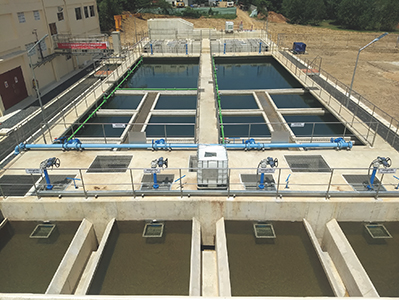(2) Water and Sanitation

A handwashing campaign at the Kule refugee camp in the Gambella region, Ethiopia (Photo: Peace Winds Japan)
Water and sanitation are vital issues linked to human life. Throughout the world, approximately 2.2 billion people are not provided with safely-managed drinking water, 4.2 billion people cannot use safely-managed sanitary facilities such as toilets, and three billion people live without access to basic hand-washing facilities. Moreover, in developing countries where piped water is not widely available, women and children often bear the role of fetching water and sometimes spend many hours on this work, which deprives children of opportunities for education and women of engaging in society. Furthermore, an unstable supply of water has a negative impact on healthcare and agriculture. From this viewpoint, Goal 6 of the SDGs sets forth the target “Ensure availability and sustainable management of water and sanitation for all.”
●Japan’s Efforts

A water treatment facility in Cambodia constructed through grant aid from Japan (Photo: JICA)
Japan has the top cumulative track record in the world in the fields of water and sanitation support since the 1990s. Japan draws on its extensive experience, knowledge, and technology in these fields to provide continuous support for promoting the provision of safe water in developing countries through the means of ODA loan and grant aid, as well as technical cooperation, including the dispatch of experts and accepting
trainees from developing countries. Japan also provides support through international organizations such as UNICEF.
In the Asia and Oceania regions, Japan implemented projects for the development and expansion of piped water in Indonesia, Cambodia, Viet Nam, and Laos. For example, in October 2019, Japan and Laos signed the Exchange of Notes for a grant aid to improve water supply services, including the construction of new water pipes in Luang Prabang City, which has a World Heritage Site. It is expected that this cooperation will contribute to the development of a sustainable urban environment by increasing the population covered by the city’s water supply from approximately 58,800 people in 2017 to approximately 70,000 people in 2025, three years after the completion of the project. In addition, in March 2020, Japan and Cambodia signed an Exchange of Notes for a grant aid to construct new water supply facilities in Ta Khmau City, where improvements to water supply capacity have become urgent following rapid population growth. This cooperation is expected to contribute to improving the quality of life in Cambodia through enabling access to safe water for approximately 120,000 residents in the region by 2030.
In addition, Japanese NGOs have been implementing water supply sanitation and hygiene improvement projects through the Grant Assistance for Japanese NGO Projects scheme. For example, World Vision Japan, a non-profit organization, is constructing sanitary facilities and conducting comprehensive, community-led sanitary improvement activities in Preah Vihear Province, Cambodia, where sanitary infrastructure is not well developed. In the first year of the project, three water storage tanks were constructed in three districts in Cambodia.
In parallel with these efforts, Japan is also providing large amounts of assistance in the field of water and sanitation that directly benefit local residents, such as the improvement of wells, water supply, and irrigation facilities, as well as disaster prevention measures through the Grant Assistance for Grass-Roots Human Security Projects. For example, Japan provided four wells in Côte d’Ivoire through the Project for the Construction of Wells in Grobiassoumé. Through this project, local residents are able to access safe water, reducing not only waterborne illness but also the manual labor of fetching water for women and children, which contributes to improvements in women’s social advancement and children’s enrollment rates.
Efforts for the improvement of the water environments in developing countries in cooperation with Japanese and local private companies and organizations are also being carried out around the world. For example, in Southwest Asia, using JICA’s SDGs Business Supporting Surveys, a verification survey with the private sector for disseminating Japanese technologies for pre-stressed concrete tanks for water supply and sewage treatment system was conducted in Sri Lanka. This project made it possible to supply 14,650 households with water, and there has been progress such as the establishment of a local field office of the Japanese company involved, which is advancing plans for the construction of new tanks.
In addition, in order to eliminate the lack of local information and knowledge with regard to the problem of serious water contamination in many Asian countries, the Ministry of the Environment (MOE) is implementing the Water Environment Partnership in Asia (WEPA). With the cooperation of the 13 participating countries Note 31 from Asia, WEPA aims to enhance water environment governance in Asia through building human networks, gathering and sharing information, and capacity building. Moreover, to contribute to achieving “halving the proportion of untreated wastewater” that is raised in Target 6.3 of the SDGs, Japan is also encouraging the spread of septic tanks in developing countries through initiatives that introduce the technology of septic tanks, legislative systems, etc. by holding workshops and seminars concerning Japan’s advanced septic tank technology, mainly for Asian regions.
- Note 31: The 13 countries are Cambodia, China, Indonesia, Republic of Korea, Laos, Malaysia, Myanmar, Nepal, the Philippines, Sri Lanka, Thailand, Viet Nam, and Japan.
